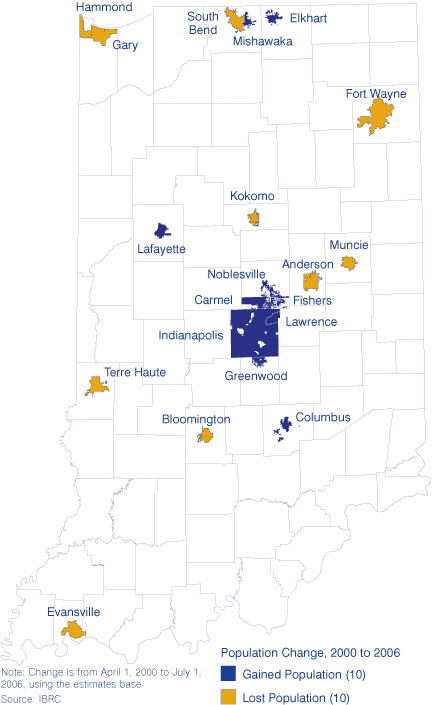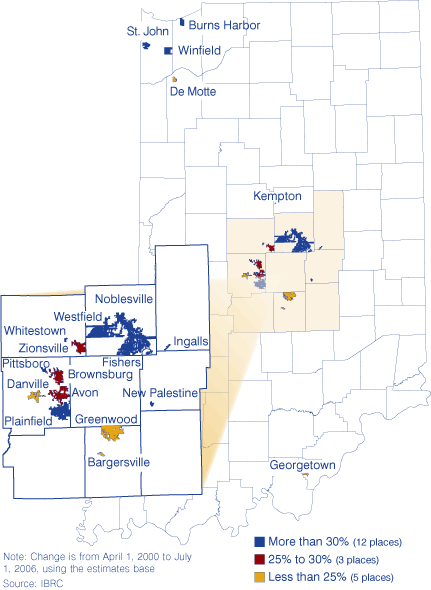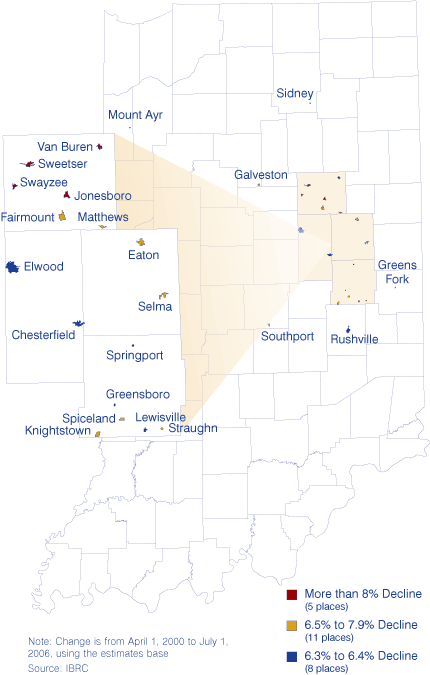Population Change in Indiana Cities and Towns, 2000 to 2006
Less than half of Indiana's cities and towns have increased in population since Census 2000, according to the recent 2006 population estimates from the U.S. Census Bureau. However, the growing places added 145,990 new residents while the shrinking places lost 60,720, resulting in a net gain for Indiana's incorporated areas overall. Like many areas around the country, more population growth is occurring in suburbs, not to mention the unincorporated areas around cities. It is important to note that these population change statistics are real population growth since annexation and boundary changes are taken into account.
The Largest
Figure 1 shows Indiana's 20 largest cities in 2006 (Fishers is technically a town, but for simplicity, let's just call them all cities). Half of these cities grew since Census 2000, led by Fishers with the addition of 23,803 people (that's an increase of 62 percent in just six years). More recently, Fishers jumped three ranks in a single year, going from the state's 12th largest city in 2005 to 9th largest in 2006 (see Table 1). The only other city in the top 20 to jump rank over the past year was Noblesville, which edged out Columbus for the 19th spot.
Figure 1: Indiana's 20 Largest Cities, 2006

Table 1: Population Change in Indiana's 20 Largest Cities, 2000 to 2006
| 2006 Rank | Name | Population, 2006 | Change Since 2000 | Percent Change, 2000 to 2006 | Change Since 2005 | Percent Change, 2005 to 2006 |
| 1 | Indianapolis | 785,597 | 3,733 | 0.5 | 2,726 | 0.3 |
| 2 | Fort Wayne | 248,637 | -1,449 | -0.6 | 1,637 | 0.7 |
| 3 | Evansville | 115,738 | -5,844 | -4.8 | 96 | 0.1 |
| 4 | South Bend | 104,905 | -3,469 | -3.2 | -302 | -0.3 |
| 5 | Gary | 97,715 | -5,031 | -4.9 | -678 | -0.7 |
| 6 | Hammond | 78,292 | -4,756 | -5.7 | -668 | -0.8 |
| 7 | Bloomington | 69,247 | -2,423 | -3.4 | 146 | 0.2 |
| 8 | Muncie | 65,287 | -2,728 | -4.0 | -791 | -1.2 |
| 9 | Fishers | 61,840 | 23,803 | 62.6 | 4,619 | 8.1 |
| 10 | Lafayette | 61,244 | 31 | 0.1 | 722 | 1.2 |
| 11 | Carmel | 60,570 | 9,635 | 18.9 | 1,634 | 2.8 |
| 12 | Anderson | 57,496 | -2,245 | -3.8 | 17 | 0.0 |
| 13 | Terre Haute | 57,259 | -2,367 | -4.0 | 292 | 0.5 |
| 14 | Elkhart | 52,748 | 242 | 0.5 | 476 | 0.9 |
| 15 | Mishawaka | 48,912 | 2,272 | 4.9 | 430 | 0.9 |
| 16 | Kokomo | 45,923 | -664 | -1.4 | -192 | -0.4 |
| 17 | Greenwood | 44,767 | 8,369 | 23.0 | 2,397 | 5.7 |
| 18 | Lawrence | 41,791 | 2,876 | 7.4 | 899 | 2.2 |
| 19 | Noblesville | 40,115 | 11,050 | 38.0 | 1,287 | 3.3 |
| 20 | Columbus | 39,690 | 623 | 1.6 | 271 | 0.7 |
Source: IBRC
The Growing
Looking at percent change, 14 of the 20 cities that have grown the most since Census 2000 are located within the nine-county Indianapolis region (see Figure 2). Of the remaining six, four (Burns Harbor, De Motte, St. John and Winfield) are found in the Gary metropolitan division, Kempton is in the Kokomo metro and Georgetown is in the Louisville metro. Ranking first on this measure, the small town of Winfield (with a 2006 population of 3,809) came relatively close to doubling its Census 2000 population with 88 percent growth. Fishers came in second with a 63 percent increase in population.
Figure 2: Indiana's 20 Fastest Growing Cities and Towns Based on Percent Change, 2000 to 2006

Numerically, however, Fishers led the state, increasing by 23,803 people in the span of six years. Noblesville added 11,050 residents and was the only other city in the state to grow by more than 10,000 people since the 2000 census.
The Declining
Meanwhile, the largest numeric population losses were felt in Evansville, Gary, Hammond and South Bend, with declines ranging from 3,469 in South Bend to more than 5,844 in Evansville. With the exception of Hammond, those changes amounted to less than 5 percent of the population.
Not surprisingly, the largest declines on a percent basis were felt in the state's smaller towns. The town of Swayzee in Grant County (with a 2006 population of 923) lost just 88 residents, but had the state's largest percent decline at -8.7 percent (see Figure 3). In fact, four of the five largest losses were in Grant County; the four other places with losses exceeding 8 percent include Sweetser, Mount Ayr (Newton County), Van Buren and Jonesboro.
Figure 3: Indiana's Fastest Declining Cities and Towns Based on Percent Change, 2000 to 2006

A Rush toward the Middle
As of 2006, a little over 35 percent of the state's population lived in the six cities with population exceeding 75,000. That percentage is down a little from 2000 because those cities lost a combined 16,816 residents. Table 2 groups Indiana's cities and towns according to their size at the beginning of the decade to see if cities of a certain size were more likely to experience population growth or decline.
Table 2: Population Change by City/Town Size Group, 2000 to 2006
| Population | Combined 2000 Population | Combined 2006 Population | Change 2000 to 2006 | Percent Change 2000 to 2006 | Number of Cities/Towns | Number of Growing Cities/Towns | Percent of Cities/Towns Growing |
| 1: More than 75,000 | 1,447,700 | 1,430,884 | -16,816 | -1.2 | 6 | 1 | 16.7% |
| 2: 50,000-75,000 | 423,706 | 423,851 | 145 | 0.0 | 7 | 3 | 42.9% |
| 3: 25,000-50,000 | 652,846 | 706,464 | 53,618 | 8.2 | 19 | 13 | 68.4% |
| 4: 10,000-25,000 | 591,002 | 616,224 | 25,222 | 4.3 | 37 | 20 | 54.1% |
| 5: Less than10,000 | 854,589 | 877,690 | 23,101 | 2.7 | 498 | 194 | 39.0% |
*Cities and towns grouped by population as of April 1, 2000 estimates base.
Source: IBRC
Among the six cities with more than 75,000 residents, only Indianapolis increased its population (0.5 percent) between 2000 and 2006. This was the only one of the five size groups with a net decline in population. At the other end of the size spectrum, only 39 percent of the 498 cities and towns with population under 10,000 grew between 2000 and 2006, though they did add a net total of 23,101 residents overall (change of 2.7 percent).
As Table 2 shows, midsize cities with populations between 25,000 and 50,000 added the most residents, both numerically and on a percentage basis of any of the five size groups; it was also the group with the largest percentage of cities growing. However, this group does include Fishers (because its population as of Census 2000 was about 38,000), and its rapid growth makes it uncharacteristic of others in this group. But even after removing Fishers from the calculation, the remaining 18 cities in the size group grew by 29,815 people, or 4.8 percent. (1)
In fact, if we continue to see Hoosiers leaving both the big central cities and the small towns, midsize cities may be the next big thing.
Notes
- If one wants to consider Noblesville an outlier in addition to Fishers, the remaining 17 cities in this size group grew by 18,765 residents for a percent change of 3.2 percent.
Rachel Justis, Managing Editor
Indiana Business Research Center, Kelley School of Business, Indiana University
